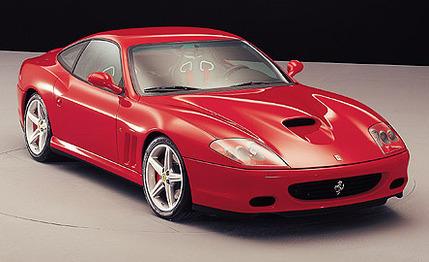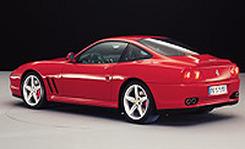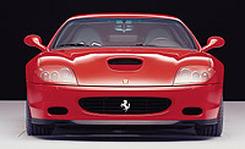
 First Drive Review
First Drive Review
It's spring in Maranello, Italy. The grass is flushed with a new hue of green, the buds are bursting forth from their branches ... and the shriek of the Ferrari Formula Uno car can be heard repeatedly zinging around the Fiorano test track nearby. There's a new Ferrari model to celebrate, the 575M Maranello.


Well, pardon our hyperbole -- the model is not entirely new. The 575M Maranello is an updated version of the 550 Maranello, the six-year-old car we recently favored over the brand-new Aston Martin Vanquish in a comparison test late last year (November 2001). Ferrari, it seems, is not content to be just slightly better -- it's in crush mode, perhaps a result of its current domination of the Formula 1 racing tour.
It wasn't too long ago that Ferraris required a lot of patience -- the unnerving arms-out driving position, the recalcitrant gearbox, the buckboard ride -- in return for their sexy shapes and race-car symphonies. Today, Ferraris demand zero excuses.
The biggest change over the 550 is the addition of the F1 gearbox, an option that will add about 10 grand to the 575M's estimated $240,000 base price. First introduced on the F355 in 1997, the F1 gearbox uses computer-controlled solenoids and hydraulic actuators to automatically shift the rear-mounted six-speed gearbox. An electric pump and a pressure accumulator supply the hydraulic pressure, with the driver changing gears via steering-wheel-mounted paddles (one on the right for upshifting and one on the left for downshifting). Or the driver can simply switch over to fully automatic mode. As on the 360 F1's box, the clutch is also computer-controlled, so there are only two pedals on F1-equipped cars -- the brake and the throttle. The 575M will also be available without the F1 system, but Ferrari expects more than 80 percent of its customers to choose it. To accommodate a gear indicator, all 575Ms have a new gauge face with a prominent center-mounted tach.
We didn't get a chance to drive a 575M with a manual gearbox, but from our experience with the outgoing 550, we'd bet on the notion that 80 percent will indeed go for the F1 system. The clutch in the 550 was heavy and the gearchange stiff, and since the 575M uses the same gearbox (it does have increased airflow to the gearbox oil cooler and larger synchros for the first and second gears, but the ratios remain the same), we bet the new car would be similarly tiresome to shift.
Without the drudgery of the left-leg stair-climbing clutch, Ferrari's V-12 coupe gains a level of grace befitting the largely unchanged and still alluring Pininfarina shell.
Not to say it's all puff and polish, however. As if the 550's 479 horsepower weren't enough, there are 29 more ponies, thanks to the updated V-12. The horsepower total is now an incredible 508. The engine still uses the same aluminum, dry-sump, 65-degree block with aluminum cylinder heads, double overhead cams, and four valves per cylinder. We know from Prodrive, the builders of the Ferrari 550 Le Mans car, that the V-12 is stout enough to handle more than 600 horsepower.
Ferrari took a smaller horsepower step, however. An increase in bore by one millimeter and in stroke by two millimeters has upped displacement from 5474 cubic centimeters to 5748, hence the 575 designation. Ferrari engineers opened up both the intake and exhaust tracks, bumped the compression ratio from 10.8:1 to 11.1:1, and fitted a drive-by-wire throttle -- a mandatory addition for the use of the F1 gearbox.


Perhaps the new juice is why Ferrari fitted F1-equipped 575Ms with a launch-control system. This system automatically adjusts clutch engagement and throttle position to give the 575M the best possible standing-start getaway. All the driver has to do is turn off the traction control, put the adjustable suspension in the sport mode, hold the brake, bring the revs to about 5250 rpm (peak torque point), and release the brake.
Once the computer realizes there's a street race going on (via the aforementioned contingencies) and the driver hits the upshift paddle when the engine has passed 6000 rpm, it also automatically adjusts the shift speed to the quickest setting, or 0.22 second per shift, a shift speed we'd be hard pressed to beat on our best day. The 575M can vary the shift speed from sedate to rifle quick depending on whether it senses hard or soft driving. Ferrari says F1-equipped cars can accelerate to 62 mph in 4.2 seconds, 0.05 second quicker than manual cars.
Owners who don't buy the F1-optioned cars won't be able to enjoy computer-controlled shifting, but they will benefit from the computer-controlled suspension that's standard on all 575Ms. There are two modes, comfort and sport. In both modes, the computer will read signals from six accelerometers and the tire-pressure warning system and then adjust the shock damping to maximize either handling or ride. Ferrari says that with the system in the sport mode the 575M generates 20 percent more cornering traction than when it is in the comfort mode, a claim we find dubious but are eager to evaluate.
Much the same goes for the burning questions: How much faster is it, and do the F1's launch control and quick shifts make for an automatic transmission that can beat a manual box? We'll have to get back to you. Ferrari is quietly confident, and with such strong demand for the car -- the two-year allotment of 440 for the U.S. is presold -- we can see why.
We have some other questions that we'll hopefully be able to answer soon, such as, where's the sonorous engine note you'd expect from a V-12, and why do the new gauges look as if they came out of a Camry? But the most nagging question of all is: Why don't we have enough money to put ourselves on the waiting list?